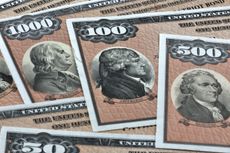The Best All-in-One Bond Funds
Our favorites stir in some foreign and domestic bonds to spread your risk and boost your return.

If you didn't own bonds over the past ten years, you missed out. in a decade during which U.S. stocks experienced two major busts, almost every major category of bonds returned at least 6% annualized -- and did so with much less drama. But as with any aspect of investing, the past is not necessarily prologue. And the performance of the past ten years certainly doesn't mean you can invest willy-nilly in any segment of the bond market and expect to do as well over the next ten.
The bond market includes at least a dozen categories, from Treasuries to speculative high-yield corporates to IOUs issued by foreign governments and companies. Most bond mutual funds specialize in only one segment of this vast marketplace. So if you want broad coverage, you might choose to buy a collection of funds -- those that specialize in, say, Treasuries, mortgages and junk, and in short-term and long-term maturities.
But there is another way to cover the bases, and it spares you the guesswork. Some bond funds have the flexibility to invest in any part of the fixed-income marketplace, both here and abroad, in both high-grade and low-quality stuff, and in maturities short, long and in between. Below, we identify five of the best all-in-one funds, sometimes also called multisector funds. Run by some of the brightest bond strategists, these funds are not for the faint of heart. The typical flexible bond fund is two-thirds more volatile than the typical domestic-bond index fund. And because these funds truly can go anywhere in the bond market, their composition may not be the same from one quarter to the next. Still, risk-averse investors should consider holding a multisector fund alongside their high-quality bonds, and the more adventurous could justify putting all their bond money into one or two of these funds.

Sign up for Kiplinger’s Free E-Newsletters
Profit and prosper with the best of expert advice on investing, taxes, retirement, personal finance and more - straight to your e-mail.
Profit and prosper with the best of expert advice - straight to your e-mail.
How much of your portfolio should be in bonds? If you can't stomach a lot of volatility and need current income, you might place all of your investments in bonds. But if you're a long-term investor, we'd encourage you to hold at least 20% to 30% of your assets in stocks. By the same token, even aggressive investors could put as much as 20% of their money in bonds.To help you find the fund that's right for you, we list our picks by the type of investor they're best suited for.
For total return
Dan Fuss and his team at Loomis Sayles Bond (symbol LSBRX) are widely regarded as some of the best bond managers on the planet, thanks to their fund's record of delivering the kinds of returns you expect from stocks over the long term. Fuss and co-managers Kathleen Gaffney, Matt Eagan and Elaine Stokes build the portfolio with a blend of big-picture economic analysis, research on individual bonds and a contrarian's instinct for investing in areas others won't touch.
When the strategy works, it produces solid results. But when other bond funds scrape their chin, Loomis gets a concussion. In 2008, for example, the team was far too early in anticipating a recovery in low-quality corporate bonds. As a result, the fund dropped 22% that year (compared with an average loss of 16% for multisector funds).
But since then, Loomis Sayles Bond has more than made up for lost ground. It soared 37% in 2009, and its 8.6% annualized return over the past ten years beats more than 90% of its peers (all returns are through December 31; see our bond-fund and bond-ETF tables for more data).
Recently, the fund's managers have grown cautious. Fuss believes that the U.S. is at the start of a long-term rise in interest rates, so the managers are gradually trimming the fund's average maturity to lessen its susceptibility to higher yields. The team also favors debt denominated in so-called commodity currencies, such as the Canadian and Australian dollars, which tend to move in tandem with commodity prices and can provide a hedge against both inflation and a sinking dollar (see Make a Buck Off a Sagging Dollar).
For interest-rate bears
Fuss and colleagues aren't alone in their concern that rising interest rates will erode bond returns over the next few years (bond prices move inversely with rates). Trimming maturities is one way of minimizing this risk. But Chris Dialynas, manager of Pimco Unconstrained Bond (PUBDX), has the flexibility to go a leap further by effectively seeking to make money from rising rates. The fund's prospectus allows him to position it in such a way that Unconstrained Bond could gain as much as 3% if interest rates were to rise one percentage point.
That's not to say the fund is a one-trick pony. The members of Pimco's lead strategy team, including Dialynas and Pimco's chief investment officers, Bill Gross and Mohamed El-Erian, generate the investment ideas that populate this and other Pimco funds. Pimco Unconstrained Bond will tend to reflect the same bets as flagship Pimco Total Return but in a more concentrated, more aggressive fashion. The only significant constraint on Dialynas is that the fund must maintain an average credit quality of at least triple-B, meaning he can't go overboard on junk bonds.
That's just as well, because Dialynas believes that junk prices today reflect an overly rosy view of the economy and corporate profits. He also thinks chances are good that the Federal Reserve's easy-money policy will eventually stoke inflation. In that case, his flexibility on interest rates could come in awfully handy.
For income
Next to Dan Fuss's nearly two decades at Loomis Sayles, Steve Huber's one-year tenure at T. Rowe Price Strategic Income (PRSNX) appears unimpressive. But Price has a superb record as a bond manager -- of its 11 taxable-bond funds that have been around at least ten years, nine have beaten the average return of their peers over the period. Four other Price sector experts join Huber on the team that determines the fund's allocation to different bond classes. Picking individual bonds then falls to teams of specialists.
Today, says Huber, "we're in more of a coupon-clipping environment" than in 2009, when rapidly ascending bond prices generated handsome double-digit returns in many sectors. He's relatively bullish on corporate bonds, figuring that many companies have cut costs and refinanced their higher-yielding debt, making it easier for them to meet current obligations. Huber is paring back exposure to mortgage bonds, in anticipation of the U.S. Treasury halting its mortgage-purchase program at the end of the first quarter of 2010.
As many a Jackson Pollock wannabe has sadly discovered, our brains' creative juices tend to flow far better when we operate within a framework of constraints as opposed to working with unfettered creative liberty. Perhaps our minds also need limits when making investing decisions. That might help explain the bang-up record at Fidelity Strategic Income (FSICX), whose managers work within rigid rules governing the fund's makeup.
Strategic Income is shaped like a barbell, with assets split between risky and safe issues. Lead managers Joanna Bewick and Chris Sharpe begin with a neutral allocation of 30% U.S. government debt, 15% developed-market government debt, 40% U.S. junk bonds and 15% emerging-markets debt. "We don't compromise by buying anything in the middle," Bewick says. Although that restriction means the fund can miss out on attractive opportunities, she says, "it makes for simplicity and clarity of decision-making."
Bewick and Sharpe tweak the allocations to adjust to market conditions and then leave the selection of individual bonds to Fidelity specialists. Ordinarily, Bewick and Sharpe don't shift the fund's mix between "safe" and "risky" assets by more than a few percentage points, but when the market calls for a bold move, they can oblige. For example, the team began shifting toward safe U.S.- and foreign-government bonds at the start of 2007, before subprime had become a household word. That allotment peaked at 60%, or 15 percentage points above the neutral weighting, in September 2008, helping to contain losses that year to 11.4%. Lately, the fund is close to its neutral allocations, with a bearish stance on U.S.-government debt and a bullish stance on junk bonds.
For extra spice
Carl Kaufman and Simon Lee arenUt bound by any explicit constraints in managing Osterweis Strategic Income (OSTIX). But they self-impose one rule: Buy what you know. So they usually avoid mortgages and bonds denominated in foreign currencies, the two areas they feel ill-equipped to judge. Because Kaufman is a former convertible-bond specialist, he and Lee tend to keep a significant portion of assets (15% to 40%) in converts. These are bonds that can be converted into a set number of the issuer's common shares and that will behave like bonds or like stocks at different times.
The managers begin their process by taking a 10,000-foot view of the bond market and the economy, seeking to identify the greatest risks for bonds. "Over the next couple of years, that risk is probably rising interest rates," Kaufman says. Then they look for attractively priced bonds that are likely to hold up against that risk. And that's leading them to buy short-term, high-yield bonds and convertible bonds that can be redeemed with the issuer for a set price within the next two to four years.
With its heavy bias toward convertibles and ordinary corporate bonds, Osterweis isn't as diversified as the other funds on this list. But its record suggests that it's worthy of your attention anyway. From its inception in 2002 through December 31, the fund returned 8.2% annualized, or two percentage points better than the average flexible bond fund, with one-third less volatility.
Three moves to make now
Use this checklist to give your bond portfolio a tune-up.
Allocate. Bonds have performed far better than stocks over the past few years, so your bond holdings may have appreciated beyond your target weighting. Adjust as necessary.
Diversify. Don’t just sit on Treasuries. Diversify with one or two of the funds recommended in this story, or fill in the gaps in your bond portfolio with the exchange-traded funds described on the next page.
Strategize. The linked forces of rising interest rates, inflation and a falling dollar threaten to eat away at your bond returns over the next several years. Keeping maturities short will help insulate you from rising rates, while owning some bonds denominated in foreign currencies can help protect you from the two other developments.

-
 Stock Market Today: Stocks Stabilize After Powell's Rate-Cut Warning
Stock Market Today: Stocks Stabilize After Powell's Rate-Cut WarningThe main indexes temporarily tumbled after Fed Chair Powell said interest rates could stay higher for longer.
By Karee Venema Published
-
 How Did O.J. Simpson Avoid Paying the Brown and Goldman Families?
How Did O.J. Simpson Avoid Paying the Brown and Goldman Families?And now that he’s died, will the families of Nicole Brown Simpson and Ron Goldman be able to collect on the 1997 civil judgment?
By John M. Goralka Published
-
 Best Banks for High-Net-Worth Clients
Best Banks for High-Net-Worth Clientswealth management Kiplinger's 2023 list of the best banks for higher-net-worth clients.
By Lisa Gerstner Published
-
 Stock Market Holidays in 2024: NYSE, NASDAQ and Wall Street Holidays
Stock Market Holidays in 2024: NYSE, NASDAQ and Wall Street HolidaysMarkets When are the stock market holidays? Take a look at which days the NYSE, Nasdaq and bond markets are off in 2024.
By Kyle Woodley Last updated
-
 Stock Market Trading Hours: What Time Is the Stock Market Open Today?
Stock Market Trading Hours: What Time Is the Stock Market Open Today?Markets When does the market open? It's true the stock market does have regular hours, but trading doesn't necessarily stop when the major exchanges close.
By Michael DeSenne Last updated
-
 Bogleheads Stay the Course
Bogleheads Stay the CourseBears and market volatility don’t scare these die-hard Vanguard investors.
By Kim Clark Published
-
 I-Bond Rate Is 5.27% for Next Six Months
I-Bond Rate Is 5.27% for Next Six MonthsInvesting for Income I-Bonds issued November 1, 2023 through April 30, 2024 will have a rate of 5.27%.
By David Muhlbaum Last updated
-
 What Are I-Bonds?
What Are I-Bonds?savings bonds Inflation has made Series I savings bonds enormously popular with risk-averse investors. So how do they work?
By Lisa Gerstner Last updated
-
 This New Sustainable ETF’s Pitch? Give Back Profits.
This New Sustainable ETF’s Pitch? Give Back Profits.investing Newday’s ETF partners with UNICEF and other groups.
By Ellen Kennedy Published
-
 As the Market Falls, New Retirees Need a Plan
As the Market Falls, New Retirees Need a Planretirement If you’re in the early stages of your retirement, you’re likely in a rough spot watching your portfolio shrink. We have some strategies to make the best of things.
By David Rodeck Published